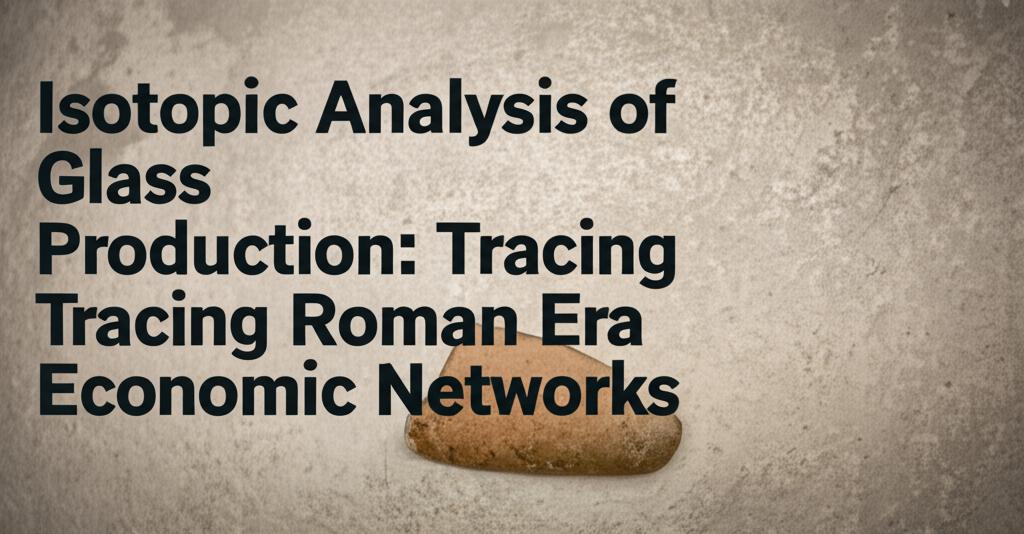Isotopic analysis of glass is a critical technique for understanding the economic networks of the Roman era. By examining the isotopic composition of elements within ancient Roman glass, researchers can trace the origins of the raw materials used in its production, primarily sand (silica), flux (like natron), and stabilisers (lime). This, in turn, sheds light on trade routes, production centers, and the scale of the Roman glass industry.
Key Isotopes and Their Significance:Several isotopic systems are employed in the study of Roman glass, each offering unique insights:
- Neodymium (Nd) Isotopes: Nd isotopes are particularly valuable for tracing the geological origin of the sand, which is the primary component of glass. Different sand sources have distinct Nd isotopic signatures based on their geological age and origin. This allows researchers to differentiate between glass produced using sands from various regions, such as the Eastern Mediterranean (Egypt and the Levant) versus the Western Mediterranean or northwestern Europe. The Nd isotopic composition is generally not significantly affected by recycling or the addition of colorants.
- Strontium (Sr) Isotopes: Sr isotopes primarily help to identify the source of the lime-bearing materials used as stabilisers in glass production. Roman glass often shows Sr isotopic compositions close to that of modern seawater, suggesting the intentional use of marine shells. However, variations can indicate other lime sources like limestone or plant ash. Recycling can affect Sr isotopic signatures, and studies have used this to investigate mixing of glass from different primary sources.
- Oxygen (O) Isotopes: Oxygen isotopes in glass are mainly influenced by the silica source. While one of the first isotopic systems applied to ancient glass, its use has been somewhat limited due to overlapping signatures from various potential silica sources.
- Hafnium (Hf) Isotopes: More recent research has highlighted the utility of Hf isotopes. For example, Hf isotopes have successfully distinguished Egyptian "Alexandrian" glass from glass produced in other Mediterranean regions, like the Levant. This is because Egyptian glass can carry a distinct Hf signature derived from minerals in Nile sediments.
- Antimony (Sb) Isotopes: Analysis of Sb isotopes has been developed to trace the provenance of antimony ores, which were used as decolourisers or opacifiers in glass. This can help identify mining activities and trade routes for these specific additives. Isotopic analysis suggests that relatively few sources of antimony ore were used for Roman glass production.
The invention of glassblowing in the 1st century BCE revolutionized glass production, transforming it from a luxury item to a utilitarian commodity widely available throughout the Roman Empire. Isotopic studies have confirmed that:
- Primary Production Centers: Large-scale primary glass production, where raw materials were melted into raw glass, occurred in specific regions, notably Egypt and Syro-Palestine. This raw glass was then often traded in chunks to secondary workshops across the empire.
- Western Production: Isotopic evidence, particularly from Sr and Nd analyses, supports ancient accounts (like those of Pliny the Elder) suggesting that primary glass production was not exclusive to the Eastern Mediterranean. Factories in the Western Roman Empire, potentially using local sands from Italy, Gaul, or Spain, also contributed to the supply.
- Trade and Distribution: The isotopic signatures of glass found in various archaeological sites allow researchers to map the vast trade networks that distributed both raw glass and finished glass objects throughout the Roman world.
- Recycling: Glass recycling was a common practice in the Roman era. Isotopic analysis can sometimes identify recycled glass through mixed isotopic signatures, indicating the melting and reuse of glass from different origins. This highlights the Romans' efficient use of resources.
- Technological Choices: Isotopic data, combined with elemental analysis, can reveal details about the specific raw materials and recipes used in different regions and time periods, reflecting technological choices and adaptations.
The field continues to evolve with advancements in analytical techniques and the growth of comparative databases for raw materials and archaeological glass. Researchers are increasingly combining multiple isotopic systems and integrating this data with elemental analysis and archaeological evidence for a more comprehensive understanding.
- Ongoing research focuses on refining the differentiation between various sand sources, especially within broader regions like the Eastern Mediterranean.
- The study of isotopes in colorants and decolourisers provides further detail on the trade of specialized materials.
- The impact of recycling on the overall glass supply and its detectability through isotopic analysis remains an active area of investigation.
- Newer isotopic systems, like hafnium, are proving valuable in resolving ambiguities that older methods couldn't address. For instance, Hf isotopes have helped to pinpoint Egypt as the origin of the highly prized colorless "Alexandrian" glass.
In summary, isotopic analysis of Roman glass is a powerful tool. It moves beyond simple typological studies of glass objects to reveal the intricate economic and technological systems that underpinned one of the Roman Empire's most significant industries. By tracing the journey of raw materials from their source to the final
product, and even through cycles of reuse, isotopic studies provide a detailed picture of Roman trade, industry, and economic interconnectedness.

